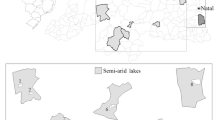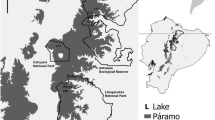Abstract
Lake Abaya and Lake Chamo are the two largest Ethiopian Rift Valley lakes; they are located close to each other, but have a strikingly different water transparency. We explain key differences in the structure and the functioning of the food web with variation in limnological variables and major pelagic food web compartments within and across both lakes. Data from a detailed comparative investigation of physical and chemical variables and zooplankton community characteristics during the wet and dry season from two consecutive years revealed major differences in key limnological variables between Lake Abaya and Lake Chamo. The most pronounced differences were related to water transparency and the amount of suspended solids in the water column. Lake Abaya is much more turbid, has lower phyto- and zooplankton biomass, and has considerably lower primary production than Lake Chamo. Based on our results, we infer that the profound differences in food web structure between both lakes probably result from differences in sediment load. Finally, our results indicate that conservation programs should focus on reducing sediment inflow from the catchments into the lakes.



Similar content being viewed by others
References
Alemayehu, H. M. & A. J. S. Raju, 2015. Towards sustainable management of Ethiopia’s Lake Chamo biodiversity resources: a geo-spatial supported approach. In Oku, E. E. & K. O. Asubonteng (eds), Harnessing Land and Water Resources for Improved Food Security and Ecosystem Services in Africa. United Nations University Institute for Natural Resources, Accra.
Aloo, P., 2002. Effects of Climate and Human Activities on the Ecosystem of Lake Baringo, Kenya. The East African Great Lakes: Limnology, Palaeolimnology and Biodiversity. Springer, New York: 335–347.
Awulachew, S. B., 2006a. Investigation of physical and bathymetric characteristics of Lakes Abaya and Chamo, Ethiopia, and their management implications. Lakes & Reservoirs: Research & Management 11(3): 133–140.
Awulachew, S. B., 2006b. Modelling natural conditions and impacts of consumptive water use and sedimentation of Lake Abaya and Lake Chamo, Ethiopia. Lakes & Reservoirs: Research & Management 11(2): 73–82.
Ayenew, T., 2007. Water management problems in the Ethiopian rift: challenges for development. Journal of African Earth Sciences 48(2): 222–236.
Ayenew, T. & D. Legesse, 2007. The changing face of the Ethiopian rift lakes and their environs: call of the time. Lakes & Reservoirs: Research & Management 12(3): 149–165.
Baxter, R., 2002. Ethiopian Rift Valley Lakes, Biology of Inland Waters. Backhuys, Leiden.
Belay, A. & R. Wood, 1982. Limnological aspects of an algal bloom on Lake Chamo in Gamo Goffa administrative region of Ethiopia in 1978. Ethiopian Journal of Science 5: 1–19.
Belay, K. & D. Abebaw, 2004. Challenges facing agricultural extension agents: a case study from South Western Ethiopia. African Development Review 16(1): 139–168.
Belay, K. T., A. Van Rompaey, J. Poesen, S. Van Bruyssel, J. Deckers & K. Amare, 2015. Spatial analysis of land cover changes in Eastern Tigray (Ethiopia) from 1965 to 2007: are there signs of a forest transition? Land Degradation & Development 26(7): 680–689.
Belete, A., L. Beccaluva, G. Bianchini, N. Colombani, M. Fazzini, C. Marchina, C. Natali & T. Rango, 2015. Water–rock interaction and lake hydrochemistry in the Main Ethiopian Rift. In Billi, P. (ed.), Landscapes and Landforms of Ethiopia. Springer, Dordrecht: 307–321.
Bottrell, H., A. Duncan, Z. Gliwicz, E. Grygierek, A. Herzig, A. Hillbricht-Ilkowska, H. Kurasawa, P. Larsson & T. Weglenska, 1976. A review of some problems in zooplankton production studies. Norwegian Journal of Zoology 24: 416–456.
Bouillon, S., R. M. Connolly & D. Gillikin, 2011. Use of stable isotopes to understand food webs and ecosystem functioning in estuaries. Treatise on Estuarine and Coastal Science. 7: 143–173.
Boxshall, G. A. & S. H. Halsey, 2004. An Introduction to Copepod Diversity. The Ray Society, London.
Dauchez, S., L. Legendre & L. Fortier, 1995. Assessment of simultaneous uptake of nitrogenous nutrients (15N) and inorganic carbon (13C) by natural phytoplankton populations. Marine Biology 123(4): 651–666.
Dejen, E., J. Vijverberg, L. A. Nagelkerke & F. A. Sibbing, 2004. Temporal and spatial distribution of microcrustacean zooplankton in relation to turbidity and other environmental factors in a large tropical lake (L. Tana, Ethiopia). Hydrobiologia 513(1–3): 39–49.
Dejen, E., W. Anteneh & J. Vijverberg, 2017. The decline of the Lake Tana (Ethiopia) fisheries: causes and possible solutions. Land Degradation & Development 28(6): 1842–1851.
Donohue, I. & J. Garcia Molinos, 2009. Impacts of increased sediment loads on the ecology of lakes. Biological Reviews 84(4): 517–531.
Ekholm, P., K. Kallio, S. Salo, O.-P. Pietiläinen, S. Rekolainen, Y. Laine & M. Joukola, 2000. Relationship between catchment characteristics and nutrient concentrations in an agricultural river system. Water Research 34(15): 3709–3716.
Flössner, D., 2000. Die Haplopoda und Cladocera Mitteleuropas. Backhuys Publishers, Leiden.
Gebremariam, B., 2007. Basin Scale Sedimentary and Water Quality Responses to External Forcing in Lake Abaya, Southern Ethiopian Rift Valley. Universität Siegen, Siegen.
Golubtsov, A. S. & R. Habteselassie, 2010. Fish faunas of the Chamo-Abaya and Chew Bahir basins in southern portion of the Ethiopian Rift Valley: origin and prospects for survival. Aquatic Ecosystem Health & Management 13(1): 47–55.
Hart, R., 1988. Zooplankton feeding rates in relation to suspended sediment content: potential influences on community structure in a turbid reservoir. Freshwater Biology 19(1): 123–139.
Hecky, R. E., H. A. Bootsma & M. L. Kingdon, 2003. Impact of land use on sediment and nutrient yields to Lake Malawi/Nyasa (Africa). Journal of Great Lakes Research 29: 139–158.
Kassawmar, N. T., K. R. M. Rao & G. L. Abraha, 2011. An integrated approach for spatio-temporal variability analysis of wetlands: a case study of Abaya and Chamo lakes, Ethiopia. Environmental Monitoring and Assessment 180(1–4): 313–324.
Kirk, K. L. & J. J. Gilbert, 1990. Suspended clay and the population dynamics of planktonic rotifers and cladocerans. Ecology 71: 1741–1755.
Korinek, V., 1999. A guide to the limnetic Cladocera in African inland lakes (Crustacea, Branchiopoda). Stuttgart, Germany.
Koroleff, F., 1970. Determination of total phosphorus in natural waters by means of persulphate oxidation Interlaboratory report No 3, Vol 3. Le Conseil International pour l’exploration de la mer.
Lemmens, P., F. E. Teffera, M. Wynants, L. Govaert, S. Deckers, H. Bauer, F. Woldeyes, L. Brendonck, S. Bouillon & L. De Meester, 2017. Intra-and interspecific niche variation as reconstructed from stable isotopes in two ecologically different Ethiopian Rift Valley lakes. Functional Ecology 31(7): 1482–1492.
Lougheed, V. L. & P. Chow-Fraser, 1998. Factors that regulate the zooplankton community structure of a turbid, hypereutrophic Great Lakes wetland. Canadian Journal of Fisheries and Aquatic Sciences 55(1): 150–161.
Makin, M., T. Kingham, A. Waddams, C. Birchall & T. Teferra, 1975. Development prospects in the Southern Rift Valley, Ethiopia. Land Resource Study, Land Resources Division, Ministry of Overseas Development, UK (21).
Meshesha, D. T., A. Tsunekawa & M. Tsubo, 2012. Continuing land degradation: cause-effect in Ethiopia’s Central Rift Valley. Land Degradation & Development 23(2): 130–143.
Oksanen, J., F. Blanchet, R. Kindt, P. Legendre, R. O’Hara, G. Simpson, P. Solymos, M. Stevens & H. Wagner, 2010. Vegan: Community Ecology Package. R package version 1.17-1. R package version: 1.17-6.
Pimentel, D., C. Harvey, P. Resosudarmo, K. Sinclair, D. Kurz, M. McNair, S. Crist, L. Shpritz, L. Fitton & R. Saffouri, 1995. Environmental and economic costs of soil erosion and conservation benefits. Science 267(5201): 1117–1123.
R Development Core Team, 2013. R: a language and environment for statistical computing. In R Foundation for Statistical Computing. http://www.R-project.org/.
Scheffer, M., 2004. Ecology of Shallow Lakes. Chapman and Hall, London.
Schröder, R., 1984. An attempt to estimate the fish stock and the sustainable yield of Lake Ziway and lake Abaya, Ethiopian Rift Valley. Archiv für Hydrobiologie Supplementband Monographische Beiträge 69(3): 411–441.
Schutt, B. & S. Thiemann, 2006. Kulfo River, South-Ethiopia as the regulator of lake level changes in the Lake Abaya-Lake Chamo system. Zentralblatt für Geologie und Paläontologie 1: 129–143.
Teffera, F. E., P. Lemmens, A. Deriemaecker, L. Brendonck, S. Dondeyne, J. Deckers, H. Bauer, F. W. Gamo & L. De Meester, 2017. A call to action: strong long-term limnological changes in the two largest Ethiopian Rift Valley lakes, Abaya and Chamo. Inland Waters 7: 129–137.
Tekelemariam, A. & B. Wenclawiak, Water quality monitoring within Abaya and Chamo drainage basin. In: Lake Abaya Research Symposium Proceedings: 109–116.
Teklemariam, A. T., 2005. Water Quality Monitoring in Lake Abaya and Lake Chamo Region. University of Siegen, Siegen.
Vijverberg, J., E. Dejen, A. Getahun & L. A. Nagelkerke, 2012. The composition of fish communities of nine Ethiopian lakes along a north-south gradient: threats and possible solutions. Animal Biology 62(3): 315–335.
Vijverberg, J., E. Dejen, A. Getahun & L. J. Nagelkerke, 2014. Zooplankton, fish communities and the role of planktivory in nine Ethiopian lakes. Hydrobiologia 722(1): 45–60.
Wagesho, N., 2014. Catchment dynamics and its impact on runoff generation: coupling watershed modelling and statistical analysis to detect catchment responses. International Journal of Water Resources and Environmental Engineering 6(2): 73–87.
Willén, E., G. Ahlgren, G. Tilahun, L. Spoof, M.-R. Neffling & J. Meriluoto, 2011. Cyanotoxin production in seven Ethiopian Rift Valley lakes. Inland Waters 1(2): 81–91.
Zinabu, G., E. Kebede-Westhead & Z. Desta, 2002. Long-term changes in chemical features of waters of seven Ethiopian Rift-Valley lakes. Hydrobiologia 477(1–3): 81–91.
Acknowledgements
This study is part of a collaborative research project “Land and water Research for Sustainable Livelihood in the South Ethiopian Rift Valley” between Arba Minch University in Ethiopia and KU Leuven in Belgium. The authors wish to acknowledge VLIR-OI and VLIR-UOS for the financial support of this research. We sincerely thank Arba Minch University and the KU Leuven Laboratory of Aquatic Ecology, Evolution and Conservation and the Division of Soil and Water Management for facilitating field work and follow-up analyses. The authors gratefully acknowledge Ethiopian Wildlife Conservation Authority and Nechisar National Park for providing us the study license in protected area of the lakes.
Author information
Authors and Affiliations
Corresponding author
Additional information
Fassil E. Teffera and Pieter Lemmens have shared first authors.
Electronic supplementary material
Below is the link to the electronic supplementary material.
Rights and permissions
About this article
Cite this article
Teffera, F.E., Lemmens, P., Deriemaecker, A. et al. Why are Lake Abaya and Lake Chamo so different? A limnological comparison of two neighboring major Ethiopian Rift Valley lakes. Hydrobiologia 829, 113–124 (2019). https://doi.org/10.1007/s10750-018-3707-8
Received:
Revised:
Accepted:
Published:
Issue Date:
DOI: https://doi.org/10.1007/s10750-018-3707-8




